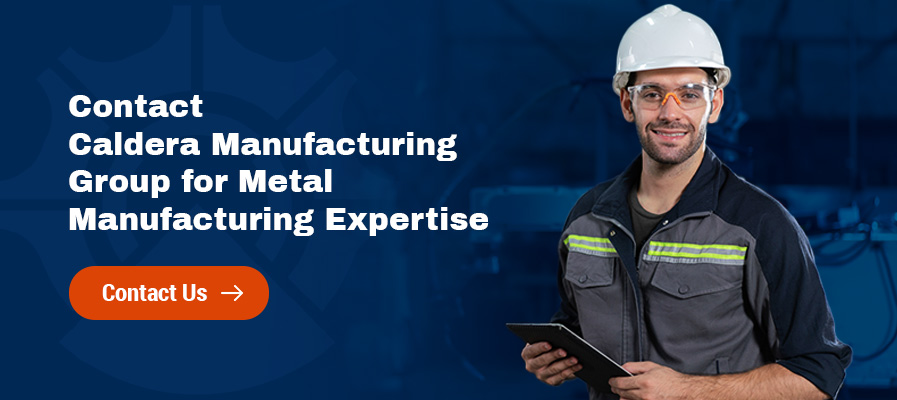Manufacturing is a field of constant innovation. Top-performing companies keep up with new developments and harness technology to stay ahead. This article will explore 11 emerging metal manufacturing technology trends and techniques that are reshaping the industry’s competitive landscape.
Robots have evolved from executing a few hazardous tasks to collaborating throughout the manufacturing process.
Compact collaborative robots, aka cobots, cooperate with humans to enhance the efficiency and safety of metal fabrication. Trends toward additional automation also include programming unaided robots for welding and other fabrication tasks.
Robots’ precise, tireless work offers many benefits, including:
Computer-aided design software enhances speed and accuracy in the metal design process.
This software facilitates 3D modeling, which enriches the customer experience. Customers can see and approve a detailed prototype of their product before fabrication. 3D modeling also improves the cost-efficiency and performance of designs through simulation and testing before manufacture.
Computer-aided manufacturing software interprets CAD designs and translates them to machines as tool pathways that bring the designs to life. Integrating CAD with CNC or 3D printing machinery streamlines the transition from design to execution for enhanced precision and efficiency.
3D printing technology has become a fixture of modern metal manufacturing. It’s a form of additive manufacturing — in other words, it builds components by adding material. 3D object scanners use raw materials ranging from powders and plastics to metals. They fabricate new components, one layer of material at a time.
3D printing accelerates fabrication, mold casting and prototyping while minimizing waste. 3D printers fabricate from 3D CAD models, ensuring accuracy and a streamlined workflow.
Metal powder bed fusion can fabricate intricate designs. This method employs reusable powder for efficiency and sustainability.
The complement to additive manufacturing is subtractive manufacturing. This method fabricates components by carving away material rather than adding it. Computer numerical control machines are the primary subtractive manufacturing tools used in metal manufacturing today.
Like 3D printers, CNC machines fabricate designs directly from 3D models for optimal precision. Automation has made CNC cutting operations increasingly efficient and safe.
While 3D printers minimize waste more effectively than subtractive processes and are more adept at fabricating intricate geometrical designs, CNC machines are more versatile and suited to larger production scales. The correct fabrication solution will depend on the metal parts you are manufacturing.
Many companies can benefit from combining both methods, taking advantage of each technique’s distinctive strengths.
The rapid transformation of manufacturing through digitization is the Fourth Industrial Revolution, aka Industry 4.0.
One defining feature of Industry 4.0 has been the influence of the Internet of Things on manufacturing, also known as the industrial Internet of Things. This term describes connectivity technologies embedded into manufacturing devices to create a network of interfaces between computers and physical devices — for example, empowering CAD and CAM software to communicate with CNC machines and 3D printers.
The IoT’s dominance in manufacturing has led to many beneficial innovations. For example:
Leaders in the metal manufacturing industry embrace the opportunities presented by digitization.
Rather than replacing human input, digital innovations position businesses to meet customer needs while expanding to conquer new markets. New technologies have improved economic prospects for generations of workers ready to learn while contributing the best human experience and insight.
Simultaneously, the opportunities created by the digitized workplace require vigilance against new threats. Cybersecurity systems have become integral to metal manufacturing companies, where designs and machine data are strategically critical assets.
Fabricated metal products are reaching new standards of strength, durability and versatility through the development of high-performance and special-purpose materials, including:
These materials’ advanced properties drive continual innovation and fresh demand from specialized industries. Staying competitive at the highest level of metal manufacturing requires awareness of material innovations and careful selection of the best materials to meet and exceed customer expectations.
Artificial intelligence is already streamlining many companies’ administrative and project management tasks.
As AI models keep improving rapidly, expect AI-powered tools to contribute more to quality control checks, machine maintenance schedules and even fabrication processes from design to welding.
Blockchain technology, which creates secure and decentralized transaction records, has various potential benefits for metal manufacturing companies, including:
Recent innovations in nanotechnology allow for the infusion of nanoparticles into molten metal to change material properties. It’s possible to adapt materials for increased responsiveness to operations like welding while enhancing strength and durability.
Like many other industries, metal manufacturing is becoming increasingly receptive to sustainability initiatives. This trend will likely continue because of the necessity imposed by resource scarcity and as a response to government regulations and incentives.
Eco-friendly manufacturing harmonizes well with technological advances. These technologies make cleaner, more efficient material use possible.
Waste reduction and recycling have become everyday priorities for metal manufacturing companies. These and other green manufacturing practices are likely to continue to spread throughout the industry.

If you need a metal manufacturing partner with large-scale production capacities, Caldera Manufacturing Group is here to support your success.
We use cutting-edge technologies and time-tested techniques to fabricate metal products that give you a competitive advantage in quality and value. Our diverse team of experts provides all the metal fabrication services you need, including:
We commit to the highest standards of excellence while reducing your lead times and costs. Contact us today to learn more or request a free quote.